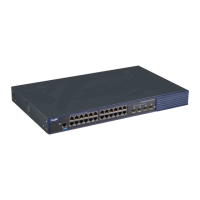Command Reference Protocol-independent Configuration Commands
6.26 route-map
Use route-map to enter the route map configuration mode and define a route map. Use the no form of
this command to remove the setting.
route-map route-map-name [permit | deny] [sequence-number]
no route-map route-map-name [{permit | deny}sequence-number]
Name of the route map. The redistribute command references the
route map according to its name. Multiple routing policies can be
defined in a route map, and each policy corresponds to one sequence
number.
(Optional) If the permit keyword is defined and the rule defined by
match is met, The set command controls the redistributed routes. For
policy-based routing, the set command controls the packet forwarding,
and exits the route map operation.
If the permit keyword is defined but the rule defined by match is not
met, the system performs the routing policy of the second route map till
the set command is executed finally.
(Optional) If the deny keyword is defined and the rule defined by match
is met, no operation will be performed. Neither route redistribution nor
policy-based routing is supported in the route map. The system exits
the route map operation.
If the deny keyword is defined but the rule defined by match is not met,
the system performs the routing policy of the second route map till the
set command is executed finally.
Sequence number of the route map. The policy with a lower sequence
number is preferred, so it’s noted when setting the sequence number.
Global configuration mode.
At present, the RGOS software primarily uses the route map for route redistribution and policy-based
routing.
1. Route redistribution control
You can redistribute the routes from one routing process to another routing process. For example,
you can redistribute the route in the OSPF routing domain and then advertise it to the RIP routing
domain, and vice versa. The mutual route redistribution can be implemented between all the IP
routing protocols.

